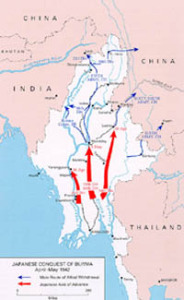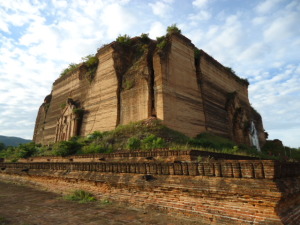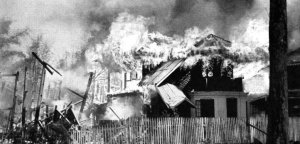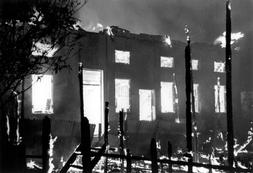January 2, 1942
Started back for Rangoon 2nd afternoon & drove straight up to the Agent’s House-cum-office

situated in Windermere Park – thickly wooded & lush green. He agreed with my assessment of the situation and was on the phone immediately to inform the Chief Secretary
of what he termed the Government of India’s assessment of the situation including the various problems connected with the Prome-Taung Up route and so on and got an immediate acceptance in principle of the Agent’s suggestions/proposals. An hour was spent discussing the next day’s programme which was entirely devoted to the situation within Rangoon city and specifically as it concerned the Indian community. It was after 12 o’clock when I got back to the Club and Father refused to allow me to turn in till he had got a detailed report regarding the Prome trip. Apart from getting familiar with the Government of India procedures, a major effort went into acquiring absolute confidence in handling the Codes for I had been made aware that I would be operating on my own shortly and it was imperative to send all reports, requests, etc. by Code, whether back to Rangoon or towards New Delhi.
The air raids on Rangoon continued on a daily cycle of day and night bombings in order to keep the population and the administration off balance. Rangoon city and its suburbs was fast filling up with Indian refugees from the south and south-east; the ones from the hinterlands further north were taking the various feeder roads joining up with the main Rangoon-Mandalay highway and the Japanese subjected these various streams to a regular dose of low level strafing with machine guns which not only caused serious casualties but also almost unthinking panic leading to further bizarre tragedies such as bridge collapses, boat capsizings and so on. From this chaos emerged an oasis of calm, disciplined and rational control in the shape of the Zeyawady Zamindari owned by the Raja of Zeyawady (Raja Sahib Sinha).
The Zamindari which had been conferred on the Sinha family of Patna, Bihar, around 1870 comprised of some 20,000 acres of rich agricultural land suitable for sugar-cane and paddy. Apart from the zamindari the family owned another 10,000 acres and the total population of share-croppers, and farm labourers with families was in the neighbourhood of approx. 20,000. The Agent was in close touch with the Raja sahib on an on-going basis and the Raja had given an assurance that he would not allow any of his people to take the road till such time as the initial congestion had eased and even then in well defined self- contained batches each with its own train of bullock carts loaded with rations to see the group though to Mandalay.

Since all the Zayawady labour was from Bihar it constituted homogenous, cohesive groups each in charge of a leader who managed to keep the groups from breaking up at least till Mandalay was reached. From then onwards it was each family for itself and the devil take the hindmost.
As a matter of historic interest the Sinha family (Bihari zamindars) had been persuaded to help the British by establishing a regular system under which indentured labour was shipped to Rangoon for various categories of work including agriculture. The Sinhas, in fact, acted as Labour Contractors and amassed a fortune from the enterprise. It was in recognition of this assistance that the British rewarded the Senior Sinha with the Zamindari and the title of Raja of Zayawady.
Apart from close personal friendship between the two families, Father had been acting as Political Adviser to the Sinhas since the early Thirties and for all I know his name still stands in the Books. The friendship stood fast in spite of several serious differences on matters of policy. Its depth and sincerity can be judged from the fact that when Father was lying seriously ill in Mussoorie on his return from Burma, the Raja Sahib thought it fit to send his eldest son all the way from Patna in order to inform Mother that the Sinhas had taken over the responsibility for Father’s treatment and she was not to worry. The son, Raj Bihari Sinha stayed in Mussoorie till such time as father was declared by the doctor completely out of danger.[1]
There was another large Zamindari in the name of Khan Bahadur Zain-ul-Abedin of Kalewa, some 200 miles north of the Capital. He was of Afghan descent , his grandfather having been exiled to Burma after the Afghan War. Unfortunately this could not be compared to the Zeyawady Estate in the matter of efficient operations and business-like administration and thus had little or no impact in the overall politics of Indian Labour Policy in Burma. We spent some wonderful holidays on the estate and it was there that I had my first sighting of a tiger, in the wild.

It was about the 3rd week of February 1942 when the Agent decided that the time had come to make a tactical withdrawal to Mandalay
by setting up a small mobile office there in order to be in position by the time the first major influx of refugees from the south hit that city in full force. I was to be in charge of operations there and was duly accredited to the Governor and the Chief Commissioner as the Agent’s representative in all matters concerning Indian refugees – their reception, shelter, medical, food and water and lastly evacuation by the Mandalay-Kalewa-Tamu-Imphal-Dimapur route. I was also to involve myself with the setting up of refugee camps along the route which had been sadly neglected until then.
We (myself and 2 permanent India-based staff) left for Mandalay by train one fine morning on the understanding that my return to Rangoon would depend on developments in the south but, in any case, I was not to leave Mandalay without specific instructions to that effect. We were in Mandalay the next morning and as I had taken the bicycle with me, I instructed my two stalwarts to remain at the station with the Codes and our meagre luggage whilst I cycled across the Irrawady river bridge

to Sagaing to meet the Commissioner and arrange some sort of accommodation for our office and living accommodation for myself and the staff.
The Commissioner, Mr. Roberts, ICS, met me most cordially and I soon had a well secured room allotted to me for the office within the Commissioner’s office complex equipped with a good safe for the sage custody of the Code Books. I was also able to rent two Burmese style bamboo cottages for myself and the staff. Having done this, I cycled back the 8 odd mile to the Railway Station, hired a ‘tikka gadi’ (horse drawn carriage) and shifted my two Tamil friends and luggage to Sagaing. We were settled in by sunset and that was the beginning of a fairly eventful phase of my life and work as a minute limb of the Government of India in Burma. The next morning was spent getting in touch with Burmese officials with whom I would have to deal and, as must be expected, I got the clear impression that things would not be all that easy. The pressure of refugees on Mandalay was increasing by the day and from an inspection of the camps set up for their reception I had the sinking feeling that we were in for big trouble – no latrines, no drinking water, no medical facilities.
The food stock – rice and salt was totally inadequate in terms of reserves. Each camp was meant to accommodate 40,000 refugees and It had been agreed that each man, woman and child above 6 would receive a cigarette tin full of rice per day together with a table-spoon full of salt. Firewood etc. had to be arranged by the refugees themselves. They reduced the problem by 3 to 4 or more families pooling their resources in order to economise on expenses.

There was a more serious problem however – the distance of the Camp sites from the City centre, invariably over six miles in each case had led to families just dumping themselves on any open ground
along the city roads creating critical public hygiene and health problems not only for the refugees but the permanent population as well. This also resulted in a running feud between the Burmese and refugee Indians resulting in senseless loss of life and property on both sides. They also constituted sitting targets for the odd Japanese raiders which sneaked in 2 or 3 times a day in order to machine gun these refugees in order to keep them of balance and in a state of terror without respite. Total lack of discipline and cohesion on the one hand and complete disregard of elementary precautions precipitated a horrendous public health problem resulting in almost 100 deaths from cholera each day.
At our request the Government of India despatched a large consignment of 2,50,000 doses of anti-cholera vaccine by air and we put into effect an attempt at immunisation of the total refugee population with the inducement of a yellow card which would entitle the holder to cross the Sagaing Bridge – the gateway to the north.

Unfortunately a large concentration of refugees was building up at the Mandalay end of the bridge and once the cholera broke out among the squalor and filth, I found it difficult to keep a tally of the daily casualties. It was one of the more gruesome situations I had the misfortune to experience.

As may be imagined, this was keeping me on the hop till late into the night, with odd trips to Maymyo the summer capital (some 40 miles from Mandalay) in order to clear matters with the Commissioner.
The news from Rangoon became increasingly alarming and the most disturbing aspect was the dichotomy between the Government version on radio and the first hand accounts from evacuees from Rangoon and Toungoo indicating that the Japanese were almost knocking on the gates of the capital and that general evacuation had been ordered. And then came the famous broadcast by the Governor of Burma one evening assuring the population that the British Indian forces had consolidated their position around Rangoon and that the Burmese Capital would prove to be a second Stalingrad. I remember telling my staff that evening that Rangoon was finished and that we were to prepare for the final exodus from Burma! So much for credibility!

All my sense of discipline and rationality seemed to fly out of the window at that moment and I convinced myself that it was essential for me to get back to Rangoon at any cost.
My main concern at that moment was how Mother would be able to face up to the chaos and total disruption of administration in the wake of a general exodus being ordered. At that moment I quite overlooked the fact that Father was holding a key position in both the military and civil arms of the Government and that Mother would also be adequately cared for.
I sent off a telegram to the Agent informing him that I would be leaving for Rangoon by the first available train unless I received specific directions from him to the contrary. Cycled down to Mandalay Railway Station the next morning and informed the Station Master of my intention to board the first available train to Rangoon. We had become quite friendly over the last few days and I liked him. He happened to be a Karen Christian, very devout, and a firm believer in Providence as a major determinant in human affairs. He flew into an absolute rage telling me bluntly that he thought I was going mad and that he would have no hand in getting me a ticket; I could get it directly at the window, myself. I did, and was told that I was only the second 1st class passenger booked so far.
The next train to down South to Rangoon was due to leave at 6 p.m. the following day and not having received any message from Rangoon till 4 p.m. I packed my ruck-sac and got to the station at 5 p.m. My two young Tamils did not know what to make of all this and the Commissioner had serious reservations about the wisdom of what I was up to. Needless to say the train was almost empty since it had been broadcast that it would be the last train to leave Mandalay. The First Class bogey was next to the engine on the very edge of the platform and as I dumped my ruck sac on to a berth, I found that my co-passenger was a large-sized, weather beaten Anglo-Indian who, on closer acquaintance turned out to be a retired Engine Driver returning to his home in Toungoo half way to Rangoon. He noticed my pipe and immediately offered me a cut from his South African rope tobacco. I discovered that he had been recently retired and was returning home after settling his account, pension etc. obviously highly satisfied with whatever he had managed to secure. He told me that apart from us there was a bogy full of girls also returning to their Convent school in Toungoo. I did not think anything of the incongruity of the situation at that time.
The station platform was crowded with refugees and their belongings and the noise level was almost that of a continuous roar. As the train was about to leave, I was leaning out of the open door and looking back idly at the crowds when I suddenly became aware of the Guard’s shrill whistle in short staccato blasts unlike the normal signal and at the same time saw the Station Master dashing down the platform shouting something at the top of his voice. The train had started to move by then but came to a halt with a jerk leaving our bogy well clear of the platform. As the train stopped the Station Master came pelting down, I suddenly realised he was shouting my name. I jumped down and he handed me the piece of yellow paper he was holding. It was a telegram from the Agent, c/o the Station Master directing me not to leave Mandalay unless so ordered. My co-passenger handed down the ruck sac, we said goodbye and wishing him well, I walked back to the Station Master’s office.
I learnt the next morning that the train was attacked by Japanese Night Fighters somewhere north of Toungoo. My friend was killed and of the 120 girls on their way to Toungoo, only 10 escaped alive. I was too stunned to realise what a touch and go affair it had been and I took quite some time for the full impact of what could have been to sink in to my brain. By the time that happened, there were other things to worry about.
____________________________________________________________________________________________________________
[1] In a letter accompanying the ms, Hashim Tyabji writes that he has recently learnt that the Raja of Zayawady’s family was closely connected with the zamindari of Dumraon, in Bihar. He adds that without his being aware of any earlier links between his family and that of Dumraon,
 the connection has continued, as evidenced by this picture, taken in 1980, of himself with Man Vijai Singh Dumraon.
the connection has continued, as evidenced by this picture, taken in 1980, of himself with Man Vijai Singh Dumraon.
To this day the area around Zayawady has the appearance of rural Bihar.

Dear Amitav,
Thank you for publishing this memoir. I was wondering if you have heard of Debendranath Acharya’s Assamese novel “Jangam” (published 1981) which also
recounts the story of Indians traveling from Burma to Assam?
Best,
Amit Baishya
University of Oklahoma
No I had not heard of this novel. Will try to look it up.
best
Amitav
Jangam is a famous Sahitya Academy Winning assamese novel. In this novel DN Acharya wrote about a journey of some Assamese and North Indian marchent and labours. Here he also describes the war and some historical data.
Dear Amitav,
I don’t think the name of the first photo caption is Windermere(Kandawgyi) because we have Windermere Park in the British times in the vicinity of Golden Valley in Yangon. Do you mean that one or simply Kandawgyi which is previously known as ”Royal Lake” in British times.
Best,